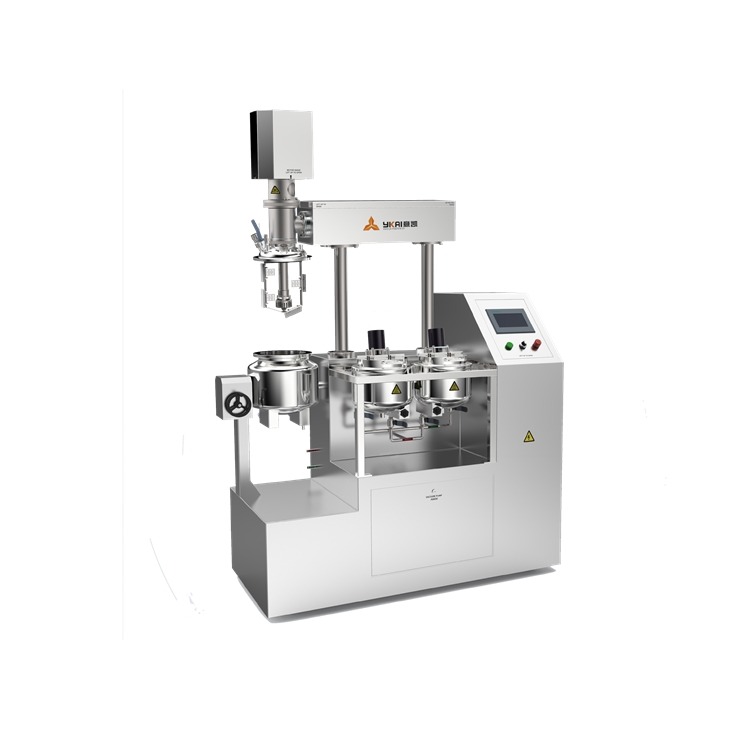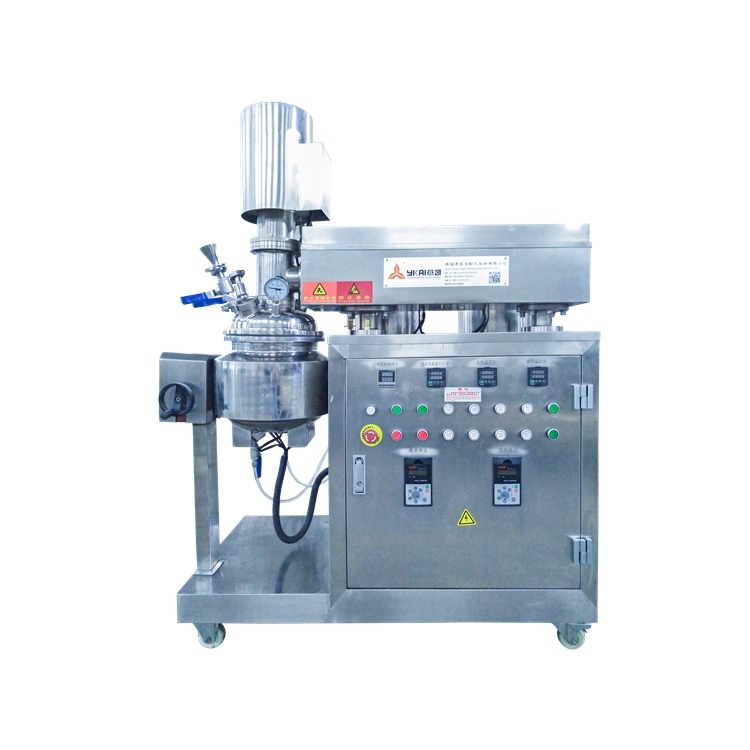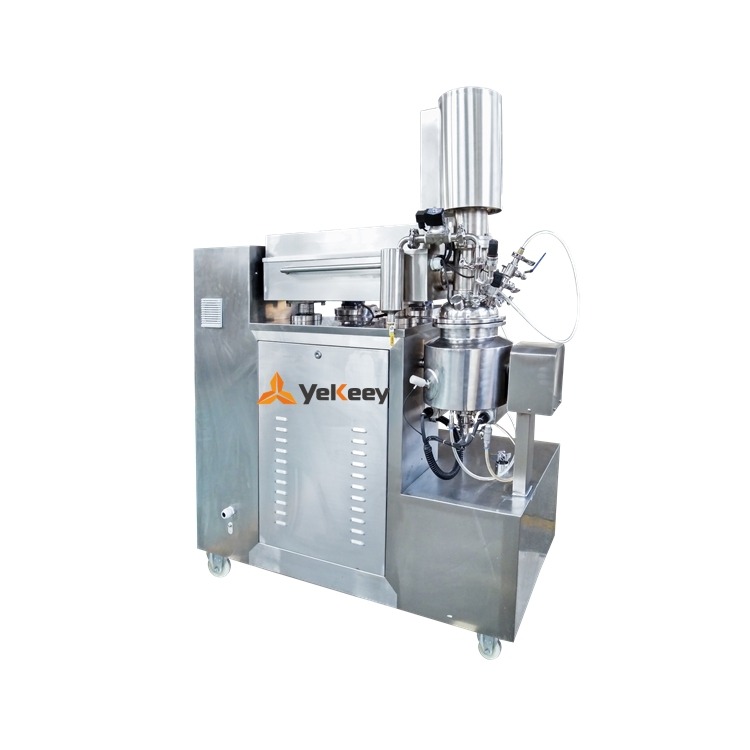-
What are the classification of laboratory mixers used in cosmetic industry?
In the cosmetics industry, laboratory mixers are mainly used for mixing, stirring, reaction and other processes. The following is the classification of laboratory mixers used in the cosmetics industry:
(1) Classified by mixing method:
- Paddle mixer: suitable for mixtures with low to medium viscosity, such as water, lotion, paint, cosmetics, etc.
- Propeller type mixer: suitable for high viscosity mixtures such as paint, resin, glue, etc.
- Centrifugal mixer: suitable for situations with low viscosity and small particles of mixtures, such as suspensions, sludge, etc.
(2) Classified by structural characteristics:
- Vertical mixer: suitable for high viscosity materials such as paint, resin, etc.
- Side entry mixer: suitable for large containers and high viscosity liquids.
- Top in mixer: suitable for small containers and low viscosity liquids.
(3) High speed laboratory mixer: used to quickly and evenly mix various ingredients in cosmetics, such as water, oil, active substances, etc. When purchasing, attention should be paid to blade material, speed, and adjustable speed range.
(4) Homogenizer: capable of homogenizing samples and achieving a certain degree of fineness through high-speed rotating blades.
(5) Magnetic mixer: Using the rotation of a magnetic field to drive the rotation of magnetic particles, it is mainly used for stirring and heating, and can also be carried out simultaneously. It is suitable for liquids or solid-liquid mixtures with low viscosity.
(6) Mechanical mixer: For example, common color screen coagulation test mixers, blue screen coagulation test mixers, digital display coagulation test mixers, etc., are designed based on the principle of electric motors, mixing rods, and mixing sealing devices.
(7) Manual mixer: It is a traditional mixing method that is more suitable for simple single experimental projects.
(8) Vacuum emulsification mixer: If the liquid medium being stirred requires pressure reduction operation, a vacuum emulsification stirring device can be used. The device is a vertical stirring kettle connected with a vacuum pump, so that the operation process can be carried out under reduced pressure, especially suitable for the production of cream, lotion, hair emulsion and other products. Due to the vacuum pumping of the entire device, even if the stirring speed is fast, there will be no bubbles in the product, but the emulsification process is completed quickly and completely; At the same time, due to negative pressure, the product does not contain bubbles, making it convenient for filling, measuring, and long-term storage of the product.
(9) Lightweight mixing: A lightweight mixer is a special mechanism that is installed on various containers to form a mixing kettle for stirring liquid media, suitable for small batch production.
-
What are the classification of laboratory mixers used in food industry?
There are various classification methods for laboratory mixers used in the food industry, and the following are some common classifications:
(1) Classified by mixing method:
- Paddle mixer: suitable for liquid mixtures with low to medium viscosity, such as beverages, condiments, etc.
- Propeller type mixer: suitable for high viscosity liquid mixtures, such as sauces, chocolates, etc.
- Centrifugal mixer: suitable for mixing granular or fibrous substances, such as grains, vegetables, etc.
(2) Classified by motor type:
- DC motor mixer: suitable for low-power and low-speed situations.
- AC motor mixer: suitable for high-power and high-speed applications.
(3) Classified by degree of automation:
- Manual mixer: requires manual operation and control of the mixing process.
- Automatic mixer: It can achieve automated mixing through program control, improving production efficiency and product quality.
(4) Classified by special needs:
- Vacuum stirrer: Stirring in a vacuum environment, suitable for occasions that require degassing.
- Explosion proof mixer: suitable for explosive and flammable situations, with explosion-proof function.
- High temperature resistant agitator: suitable for stirring in high-temperature environments, with high temperature resistance performance.
(5) Classified by material:
- Stainless steel stirrer: suitable for the food and pharmaceutical industries, with good corrosion resistance and hygiene.
- Plastic mixer: suitable for some lightweight stirring and mixing, with a relatively low price.
(6) Classified by application field:
- Beverage industry mixer: suitable for mixing, blending, and homogenizing beverages.
- Dairy industry mixer: suitable for stirring, mixing, and fermentation of dairy products.
- Seasoning industry mixer: suitable for the mixing and blending of seasonings.
- Grain industry mixer: suitable for mixing and processing grains.
(7) U-shaped mixers, drum mixers, and drum mixers are all named based on their structural characteristics and application areas, each with its specific usage scenarios and advantages.
Please note that the above classification is not absolute, and different types and brands of laboratory mixers may have multiple functions and application ranges. When selecting a suitable laboratory mixer, it is necessary to consider the actual needs and experimental conditions comprehensively.
-
What are the advantages of lab mixers?
Laboratory mixers have many advantages in the laboratory, which can improve experimental efficiency and accuracy of experimental results. Here are some main advantages:
(1) Efficient mixing: The laboratory mixer can quickly and uniformly mix various liquids, improving experimental efficiency. It can ensure the accuracy and stability of experimental results by precisely controlling parameters such as stirring speed, time, and temperature.
(2) Accurate control: The laboratory mixer can precisely control the mixing speed, time, temperature and other parameters of various materials, ensuring the accuracy and stability of experimental results. At the same time, it can also be customized according to different experimental needs, with strong adaptability.
(3) Easy to operate: The laboratory mixer is easy and convenient to operate, which can save labor costs and improve experimental efficiency. It usually adopts an intelligent control system to achieve visual operation and automatic control of the mixer.
(4) Diversified design: There are multiple models and specifications of laboratory mixers that can meet the needs of different experiments. It can also be customized according to the special needs of users, with strong adaptability.
(5) Hygiene and safety: The design of laboratory mixers usually complies with hygiene and safety standards, and can avoid dust and pollution during experiments. It is also equipped with various safety protection devices to prevent accidents from occurring.
(6) Good repeatability: Laboratory mixers can provide reproducible and consistent experimental results due to their precise control and repeatability characteristics. This is crucial for laboratory work that requires precise and reliable experimental results.
(7) Easy to clean and maintain: Laboratory mixers are usually designed to be easy to clean and maintain, ensuring the long-term use and reliability of the equipment. This is crucial for maintaining the performance of the device and extending its lifespan.
(8) Space saving: Laboratory mixers are usually designed to be compact and space saving, able to meet the needs of modern laboratories. This is an important advantage for laboratories with limited space.
(9) Scalability: The design of laboratory mixers usually has scalability and can be upgraded or expanded according to user needs. This is very important for laboratories that need to upgrade their equipment over time.
-
What are the advantages of lab mixers?
The disadvantages of laboratory mixers include the following:
(1) High energy consumption: Although laboratory mixers can quickly and uniformly mix various liquids, their operation usually requires a large amount of energy. Therefore, there may be higher energy costs during use.
(2) Noise pollution: Laboratory mixers may produce significant noise during operation, which may have a certain impact on the laboratory environment and even pose a potential threat to the hearing health of workers.
(3) High maintenance costs: The maintenance and repair of laboratory mixers may require professional skills and tools, which may result in higher maintenance costs.
(4) High cost: The price of laboratory mixers is usually high, which may impose a burden on some laboratories with limited budgets.
(5) Environmental impact: Although most modern laboratory mixers are equipped with filtration and recovery systems to reduce pollution, they may still have a certain impact on the environment.
-
What is the most efficient lab mixer?
Certainly Yekeey laboratory mixer.
As one of the leading manufacturing factories of homogeneous emulsification mixers in China, Yekeey not only has thousands of laboratory mixer application cases, but also can provide customized services according to the specific materials of yours, improving the effect of cutting and mixing, greatly reducing production costs for customers, and creating more profits.










I am not sure where youre getting your info but good topic I needs to spend some time learning much more or understanding more Thanks for magnificent info I was looking for this information for my mission
Somebody essentially lend a hand to make significantly articles Id state That is the very first time I frequented your website page and up to now I surprised with the research you made to make this actual submit amazing Wonderful task